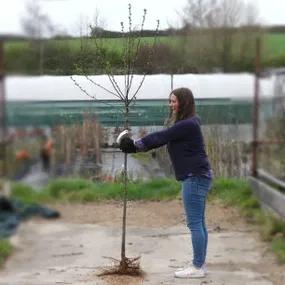Hupeh/Tea Chinese Crab Apple, Large Trees
Honest Delivery Prices- China. White-pink flowers, red fruit
- Won't pollinate other apple trees.
- Max. Height: 8m
- RHS Plants for Pollinators
- RHS Award of Garden Merit
- Bareroot Delivery: Nov-Mar.
Recommended extras
Description
Malus hupehensis: Bareroot Hupeh / Tea Crab Apple Trees in Standard Sizes
Malus hupehensis is a Chinese crab apple tree, known as the Hupeh / Hubei / Hupei Tea Crab apple. This small, goblet shaped tree is covered with white blossom in spring, sometimes touched with pink, which matures into bright red fruit that look like cherries and either make the most delightful pink crab apple jelly, or adorn the branches well into winter. It looks superb in Autumn and makes a lovely specimen for the centre of a lawn.
Older trees will start to spread out and can develop a wide, rounded canopy up to about 6 metres tall.
Browse our variety of crab apple trees or our full range of trees.
Delivery season: Crab apple trees are delivered bareroot during late autumn and winter, approximately November-March inclusive.
Choosing a size: Small trees are cheaper, easier to handle and more forgiving of less than ideal aftercare, so they are best for a big planting project. If instant impact is your priority, or if you are only buying a few plants for use in a place where it is convenient to water them well in their first year, then you may as well use bigger ones. All our bareroot trees are measured by their height in centimetres above the ground (the roots aren't measured).
Features:
- Height: 6m
- Soil: Any well drained
- Use: Specimen, small gardens, urban
- Colour: Mostly white blossom in May
- Cherry-like crabs remain on branches into winter
- Does not pollinate orchard apples
- RHS Award of Garden Merit
- RHS Plants for Pollinators
- Bareroot delivery only: November-March
Growing Hupeh Crab Apple Trees
Any well drained soil, tolerates partial shade and urban pollution well. It is drought tolerant and not bothered by strong winds, but can't grow on the coast.
Please Note: This tree is sterile and will not pollinate other apple trees. If you are looking for a pollinator for an orchard choose either John Downie and Golden Hornet. The bees don't mind, however, and will eat their fill.
Planting Instructions
Notes on planting Malus hupehensis:
Crabapples are tough plants that thrive in any moderately fertile soil. They tolerate shade well, although we recommend planting them in full sun to get the best display of flowers and fruit. Although a moist, well drained site is ideal, crabapples like heavy clay and don't mind a bit of waterlogging in winter.
They won't grow in deep shade and may struggle in very poor dry soil, although this variety is noted for being drought tolerant.
Prepare your site before planting:
It is good to dig over the site where you plant a tree several months in advance. Kill the weeds first: for tough weeds like nettles, brambles and ground elder, you will usually need a weed-killer to get rid of them. When you dig the soil over, remove stones and other rubbish and mix in well rotted compost or manure down to the depth of about 2 spades.
Watch our video on how to plant a tree for full instructions.
Remember to water establishing trees during dry weather for at least a year after planting.
Tree Planting accessories:
Prepare your site for planting by killing the weeds and grass.
You can buy a tree planting pack with a wooden stake & rubber tie to support the tree and a mulch mat with pegs to protect the soil around the base of your tree from weeds and drying out.
We suggest that you use mycorrhizal "friendly fungi" on the roots of all newly planted large trees: if your soil quality is poor, we strongly recommend it.
You can also improve your soil with bonemeal organic fertiliser.
Did You Know?
This tree is native to China and Japan. The prolific botanical explorer Ernest Wilson was introduced to it in China's Hupeh province (now spelt Hubei) and brought it to Britain in 1900 for Veitch Nurseries, who were one of the largest plant breeders in Europe at the time, able to fund grand expeditions for new, exotic stock. It has won both an RHS Award of Garden Merit and the Award of Merit for its cut flowers. It was previously classified as Pyrus malus and Malus theifera.
The young leaves are used as a tea substitute; we don't know if they contain caffeine, but the flavour is good, and it is said to be a source of selenium.
Standard trees are measured by their girth in centimetres 1 metre above ground level: their trunk's waist measurement. Unlike sapling trees and hedge plants, standards aren't measured by their height, which will vary quite a bit both between and within species.
So, a 6/8cm standard tree has a trunk with a circumference of 6-8cm and an 8/10 standard has a trunk 8-10cm around. This measurement makes no difference to the tree's final height.
On average, standard trees are 2-3.5 metres tall when they arrive, but we cannot tell you precisely how tall your trees will be before we deliver them.

 1.webp)
 1.webp)
 2.webp)
 3.webp)
